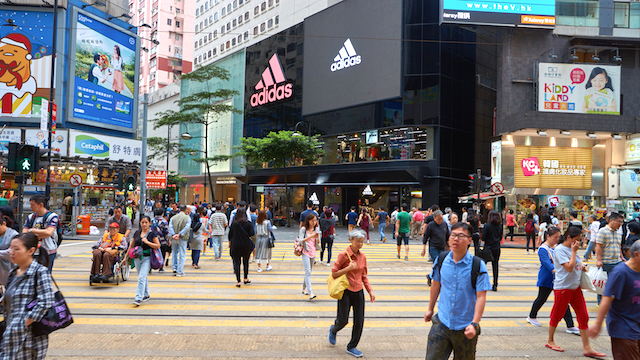International brands are disproportionately favoured in China’s apparel market, undermining local labels, a new report reveals.
With double-digit growth for decades, the market has emerged as a key battlefield for brands, says The China Apparel Market: Indigo is the New Blue, a report launched by global consulting company OC&C Strategy Consultants.
It says China has surpassed the US to become the biggest apparel market in the world, valued at close to US$300 billion.
Its frontrunners predominantly international, with Uniqlo, Adidas and Jack & Jones occupying three of the top five spots, posing an imminent threat to the current domestic champion Heilan Home. Among the top 60 brands in China, the combined share of Chinese players dropped to 59 per cent last year, down from 64 per cent in 2011.
In examining the dynamics of China’s apparel market, the OC&C survey had several pillar questions: How are local brands generally perceived by Chinese consumers? What are Chinese consumers looking for when they pursue Chinese brands vs. international labels? Are there differences in the way Chinese brands work that could explain their challenges? What are their strengths and weaknesses against the key drivers of retail performance?
“Despite the slowdown since 2010, China still presents lucrative opportunities,” says OC&C Greater China partner Jack Chuang. “If local apparel brands are to regain dominance, developing a strong understanding of Chinese shoppers will be pivotal.”
Top reasons
According to the survey, “patriots” of local brands are younger and typically come from lower income brackets. They are also frequent small-ticket shoppers who have less to spend on apparel, which makes “value for money” (40 per cent) and “Chinese elements” (39 per cent) the top reasons they choose Chinese brands.
Shoppers opting for international apparel brands, meanwhile, rate “better quality” (34 per cent) and “better design” (33 per cent) as their most important criteria. When asked why they don’t but Chinese brands, “poor design” (37 per cent) ranked top, followed by “insufficient choices within the same category” (22 per cent).
“While Chinese apparel brands have gained more acceptance, our research suggests they are still held back by less competitive marketing strategies and product design,” says Chuang.
He notes intense competition for customers, especially female in their 20s to 30s, with some foreign apparel manufacturers spending significantly on marketing compared to the 2 to 3 per cent spent by Chinese companies such as Heilan Home and La Chapelle.
“Chinese consumers want more personalised styles, branding and distribution, such as local brand JNBY offers,” he says. “They want to express their personal identity and perspectives on life through fashion, which has translated into salient demand for differentiated brands, products and retail experiences that resonate on an emotional level.”
Less impact
Part of the reason Chinese apparel brands fail to achieve cut-through like their international counterparties is their tendency to distribute through department-store boutiques, often on upper floors, says the report.
Meantime, foreign firms such as Zara have the impact of large storefronts at street level.
Also, Chinese retailers overuse repetitive price promotions to help clear inventory, diminishing perceived brand value.
And despite China’s move to e-commerce, there is still excessive reliance on bricks-and-mortar distribution in the face of escalating rents.
However, the report says there is scope for Chinese brands to improve inventory control using an agile supply chain based on POS data collection and analysis. “Data would support more streamlined product offerings targeted at specific locations.”
The study shows that inventory book value reached 30 per cent of annual revenue for some retailers as against 11 per cent for Zara, and that many are well below the industry standard inventory turnover rate.
OC&C ran its consumer survey over March and April, with 2450 respondents from a range of demographic groups across 22 cities in China. The company has more than 400 consultants in 14 offices globally, including Greater China and India. The Greater China practice has offices in Hong Kong and Shanghai.






